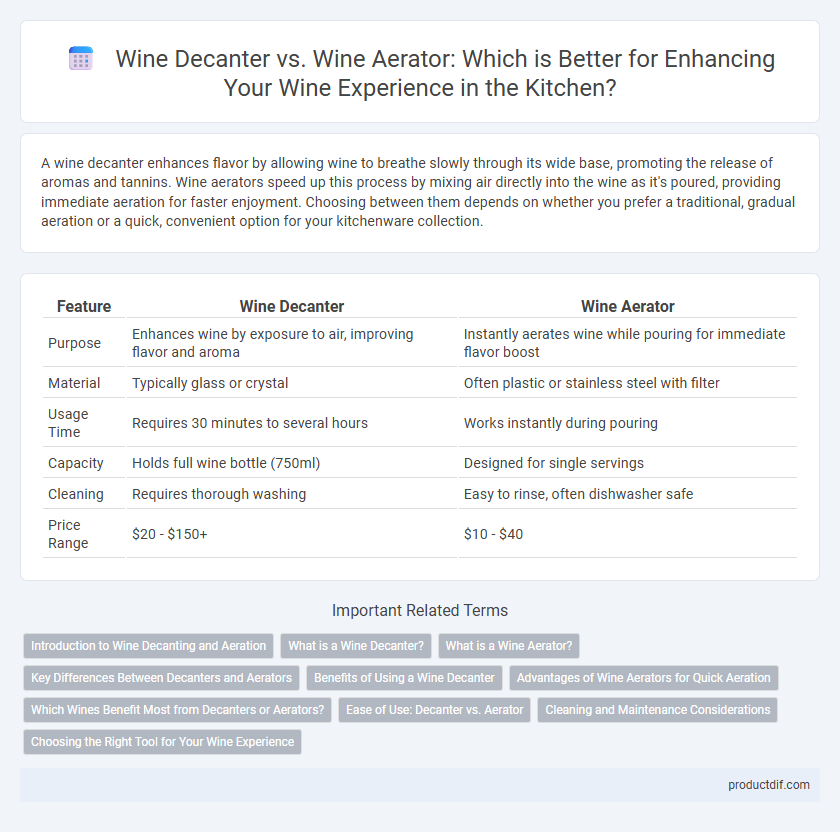A wine decanter enhances flavor by allowing wine to breathe slowly through its wide base, promoting the release of aromas and tannins. Wine aerators speed up this process by mixing air directly into the wine as it's poured, providing immediate aeration for faster enjoyment. Choosing between them depends on whether you prefer a traditional, gradual aeration or a quick, convenient option for your kitchenware collection.
Table of Comparison
| Feature | Wine Decanter | Wine Aerator |
|---|---|---|
| Purpose | Enhances wine by exposure to air, improving flavor and aroma | Instantly aerates wine while pouring for immediate flavor boost |
| Material | Typically glass or crystal | Often plastic or stainless steel with filter |
| Usage Time | Requires 30 minutes to several hours | Works instantly during pouring |
| Capacity | Holds full wine bottle (750ml) | Designed for single servings |
| Cleaning | Requires thorough washing | Easy to rinse, often dishwasher safe |
| Price Range | $20 - $150+ | $10 - $40 |
Introduction to Wine Decanting and Aeration
Wine decanting involves pouring wine from its bottle into a decanter to separate sediment and allow oxygen to enhance flavor development. A wine aerator accelerates this oxygenation by mixing air directly into the wine as it is poured, intensifying aroma and taste instantly. Both methods improve wine complexity, but decanters suit older, sediment-rich wines while aerators are ideal for younger, more tannic varieties.
What is a Wine Decanter?
A wine decanter is a specially designed vessel used to separate sediment from wine and enhance its flavor by allowing it to breathe through gradual exposure to air. Typically made from glass or crystal, it features a wide base to maximize the wine's surface area for oxygen absorption, which helps to soften tannins and release aromatic compounds. Unlike wine aerators, which provide immediate aeration through rapid mixing with air, wine decanters offer a slow, controlled oxidation process ideal for older red wines and full-bodied varieties.
What is a Wine Aerator?
A wine aerator is a specialized device designed to rapidly expose wine to oxygen, enhancing its flavor and aroma by accelerating the aeration process. Unlike traditional wine decanters, which require extended time to breathe, aerators instantly mix air with wine, softening tannins and releasing bouquet for immediate enjoyment. These compact tools are ideal for improving young red wines and delivering a smoother, more balanced taste in just seconds.
Key Differences Between Decanters and Aerators
Wine decanters provide a spacious environment that allows wine to breathe through slow oxidation, improving flavor and aroma over time. Wine aerators introduce air rapidly by mixing oxygen directly with the wine during pouring, delivering immediate enhancement of taste and bouquet. The key difference lies in the process duration: decanters are ideal for extended aeration, while aerators offer quick, on-the-spot oxygenation.
Benefits of Using a Wine Decanter
Using a wine decanter enhances the flavor profile of red wines by allowing oxygen to interact with the wine, softening tannins and releasing complex aromas. Decanters also help separate sediment from aged wines, ensuring a cleaner pour and improving overall taste. The elegant design of a wine decanter adds a sophisticated touch to wine presentation, making it ideal for formal dining and wine tasting experiences.
Advantages of Wine Aerators for Quick Aeration
Wine aerators provide rapid oxygen exposure, enhancing the flavor and aroma of wine instantly compared to traditional decanters. Their compact design allows for effortless use during pouring, making them ideal for casual and spontaneous drinking occasions. Unlike wine decanters that require extended breathing time, aerators deliver immediate aeration, perfect for unlocking complex wine profiles on demand.
Which Wines Benefit Most from Decanters or Aerators?
Full-bodied red wines like Cabernet Sauvignon, Merlot, and Syrah benefit most from wine decanters, as the extended aeration softens tannins and enhances complex aromas. Lighter reds and young wines, such as Pinot Noir and Beaujolais, respond well to wine aerators, which provide quick oxygenation to release fresh fruit flavors. Delicate white wines typically do not require decanting or aeration, preserving their crispness and subtle notes.
Ease of Use: Decanter vs. Aerator
Wine aerators offer superior ease of use by allowing immediate aeration directly into the glass, eliminating the need for pouring and waiting. Wine decanters require more handling and time, as the wine must be poured into the vessel and left to breathe before consumption. For quick and convenient wine enhancement, aerators are often preferred over decanters.
Cleaning and Maintenance Considerations
Wine decanters require thorough cleaning to remove wine residues that can affect flavor and appearance, often involving rinsing with warm water or using specialized brushes and cleaning beads. Wine aerators typically demand less maintenance, with most models easily rinsed under running water after each use to prevent buildup. Proper cleaning of both wine decanters and aerators helps preserve their material integrity and ensures optimal wine taste during multiple servings.
Choosing the Right Tool for Your Wine Experience
Selecting the ideal wine accompaniment involves understanding the key functions of a wine decanter and a wine aerator. A wine decanter allows for gradual oxygen exposure, enhancing flavor complexity over time, making it ideal for bold red wines needing extended breathing. Wine aerators provide immediate aeration by mixing air with wine as it is poured, perfect for quick serving and improving youthful or less complex wines instantly.
Wine decanter vs Wine aerator Infographic

 productdif.com
productdif.com